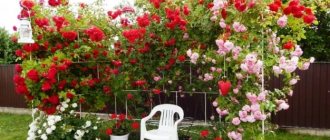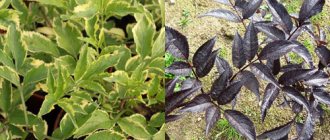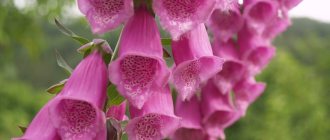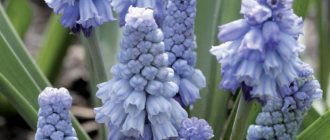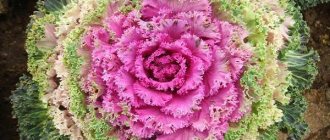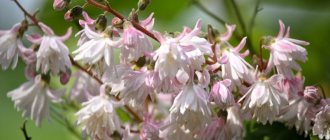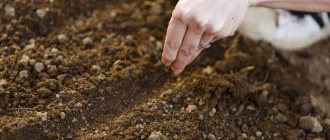The tree grows up to 15 m. The crown is openwork, spreading in young trees, oval in adults. The branches are thin, flexible, drooping, grayish-pubescent. Small leaves are elliptical in shape, smooth, sometimes symmetrical, dark green in summer, turning yellow in autumn. The leaves are arranged in two rows, so the shoots look covered with large feathery leaves, for this reason the name was given to the species. The flowers are small, collected in bunches.
Article on the topic: Segu chestnut description and features
The pinnate elm is quite winter-hardy and freezes slightly in severe winters. Resistant to drought, undemanding to soil. It grows very quickly. But trees reach large sizes only in the southern regions on well-moistened soils. Tolerant to urban conditions, asphalting, street dust, smoke. Beautiful in decorative plantings, but does not provide street shade. You can form a more compact and dense crown by pruning.
Squat elm is also called small-leaved elm (Ulmus pumila L) . It grows in the wild in the Far East, northern Mongolia, Japan, Korea, and Transbaikalia.
Found in deciduous and mixed forests, prefers fertile soils.
Low, grows up to 15 m, sometimes grows as a shrub with a dense, rounded crown. The branches are thin, young pubescent. The leaves are small, elliptical, leathery, with a sharp short apex, somewhat unequal.
In spring, the leaves are green, the lower part of the leaf is light green. The leaves darken in summer and turn olive-yellow in autumn. Flowers are collected in small bunches. The winged seeds are ocher or yellow-brown. Winter hardiness is average, this species is light-loving, unpretentious to the soil, its richness and moisture.
Squat elm is drought-resistant and tolerates shaping and pruning well. Develops in urban environments.
This species easily tolerates replanting and is very good for landscaping in dry areas. The undoubted advantage of elm is the absence of root suckers; this is a wonderful quality for garden and park construction. It is used in landscaping new buildings, creating trimmed hedges, and street plantings.
The related elm has a second name - Japanese birch bark (Ulmus propinqua Koidz = U. japonica(Rehder) Sarg) . Grows in eastern Transbaikalia, Mongolia, Japan, Northern China, and the Far East. Distributed in cedar-broad-leaved valley forests.
This type of elm is a large plant up to 35 m in height, beautiful, with a regular, even, straight trunk, a wide spreading crown, and quite dense.
The bark is whitish on the trunk, brown on the shoots, smooth or with corky growths, it looks beautiful when the plant is not covered with foliage.
Young shoots have thick pubescence and dark brown buds. The obovate leaves have an unequal base and grow on a short petiole. The leaves are rough-pubescent on top and fluffy underneath. In spring the foliage is green, in summer it darkens, in autumn it is brownish-red, dark crimson, brown-chestnut, the leaves are whitish below. The flowers are small, reddish, collected in bunches. The winged seeds are yellow-brown in color.
Japanese birch bark grows faster than other elms and tolerates shading, frost, and urban conditions. Propagated by root suckers and seeds. Good for landscaping cities, parks, green buildings. Particularly beautiful in autumn.
Rough elm is also called mountain elm (Ulmus scabra Mill. = glabra Huds) . It grows in the Balkans, Scandinavia, European Russia, Asia Minor, and Central Europe.
Distributed in broad-leaved and coniferous-deciduous forests, usually on calcareous soils.
This species has a wide, rounded crown, quite dense, and grows up to 35 m under good conditions. The bark is smooth, dark brown, dark brown on the branches. Young branches are densely covered with hairs. The leaves are large, up to 17 cm in length.
Obovate, with sharp teeth along the edge. The top of the leaves is rough, the bottom is coarse. The foliage is dark green, turning yellow in autumn. The flowers are inconspicuous, collected in spherical bunches, growing on long stalks. Elm blooms for up to 7 days.
The seeds are large, winged, greenish.
This elm grows quickly; unlike many other species, it is demanding of the soil and its moisture. It grows well in shaded areas, is frost-resistant, tolerates urban conditions well, and is drought-resistant.
Elms: trees and shrubs. Description, growing conditions, application
Trees of the genus elms (or, as they are less commonly called, elms) belong to the deciduous Elm family. They grow in abundance in Western Europe, the Volga region, the southern part of European Russia, the southern Urals, Central Asia, and the Caucasus.
It has been established that elms separated into an independent genus, consisting of several dozen species, approximately 40 million years ago. Some species are more often called elm, birch bark, and in the areas of distribution of Turkic languages, small-leaved and squat elms are called “elm”. The most common type is the common or smooth elm.
Elm is reflected in the cultures of various ethnic groups. Our ancestors believed that the branches of this tree bring good luck and endow the traveler with strength and courage. In Christianity, it symbolizes human dignity. For many other peoples, the elm was a symbol of motherhood, birth and new life. In Britain, an elm branch along with a grapevine is a symbol of lovers.
Decorative forms of fruit trees
The familiar apple tree has many decorative subspecies that bloom more abundantly than ordinary apple trees. Blooming with scarlet flowers, the Ola apple tree is simply filled with flowers so that the branches are not visible
.
Apple tree color Ola
Ornamental varieties are grown using familiar agricultural techniques familiar to gardeners for caring for traditional apple trees. Fruits - small (paradise) apples decorate the garden until late autumn
. Yellow, red, purple - look great on branches. They attract birds to the garden, a modern option for a natural solution to pest problems. Apples of paradise make original jam. Especially interesting are the weeping forms, with variegated and colored leaves.
Popular types
The following types of elm tree are described.
Hornbeam
Hornleaf elm is found in Central Asia, the Caucasus, Europe and North Africa. This is a light-loving deciduous tree, but it also grows in the shade without any problems. It reaches a height of twenty-five meters, the maximum diameter of its crown is ten meters.
Elms are characterized by a high growth rate and tolerate pruning well, making these trees well suited for forming hedges. They will look great on a well-kept lawn. In appearance they go well with bird cherry, rowan, as well as apple and cherry trees.
The biological description of this species is as follows. Corky growths sometimes appear on dark brown branches. The pointed leaves are large in size , smooth on top, and their underside is covered with delicate hair. The foliage, dark green in summer, changes its color to bright yellow in autumn. Even before the leaves appear, small flowers bloom, collected in bunches.
Related article: Beech description and features
They are unpretentious and can withstand frost and drought very well. When grown in favorable climatic conditions, their age can be up to three hundred years. Hornbeam elm is used medicinally. It is used to prepare diuretics and antiseptics. Its bark has the ability to slow down the absorption of cholesterol. A decoction of elm bark is also used to treat burns and some skin diseases.
Hornleaf elm prefers rich, moist soil. For active, high-speed growth, it requires periodic watering and fertilization, for example, adding lime to the soil, which has a beneficial effect on the tree.
Recommendations for growing:
- Nutritious, moist soil is better suited;
- Periodically, elms should be fertilized with lime.
if natural moisture is insufficient, trees require watering;
Smooth elm is also sometimes called common and large-leaved elm. Distributed throughout Europe. It grows up to twenty, and in rare cases up to forty meters in height. It has a wide crown with a diameter of up to twenty meters. The trunk of such an elm is straight, with a diameter of up to one and a half meters. The bark covering young shoots is smooth, but with age it becomes rougher, cracks and begins to flake off. Large leaves have a pointed or ovoid shape. The upper side of the leaf is dark green, the lower side has a lighter shade. In autumn the foliage changes color to brownish purple. Small brown flowers bloom in spring .
These plants are characterized by a developed root system. In mature trees, thick roots can protrude from the trunk to a height of up to half a meter above the ground. The tree grows quickly, and its lifespan can sometimes be four hundred years. Tolerates drought well, but prefers moist soil. It tolerates short-term flooding without any difficulties.
The common elm tree has dense , durable wood, but is quite easy to process. This tree is widely used in the production of furniture and other carpentry. Elm does not rot in water, so in the Middle Ages water pipes and supports for piers and bridges were made from it. Smooth elm bark was used in tanning leather.
Elm is also of great benefit in urban areas - its leaves can retain a much larger amount of dust than other trees. Thanks to their extensive root system, elms are well suited for strengthening the soil on the sides of ravines and on cliffs.
Androsova elm is an artificially obtained hybrid of squat and dense elms. A mature tree can reach twenty meters in height. It has a dense spherical crown, thanks to which it provides good shade. Covered with gray bark. The leaves, like those of many elms, according to the description, have an ovoid or pointed shape.
It often grows in moist soils, but can easily tolerate drought . It forms many side shoots , making it excellent at capturing dust in urban environments. The crown of this tree lends itself well to shaping, which allowed the elm to become one of the most popular garden plants.
-loving perennial ornamental plants grow well under the canopy of elm crowns
- Wolfsbane (Wrestler);
- Bell;
- Buzulnik Przhevalsky;
- catchment;
- Saxifraga;
- Asparagus;
- Ferns;
- Astilbe.
Dense elm is rare in nature, mainly in Central Asia. This large tree can reach a height of up to thirty meters. Its developed crown has a pyramidal shape and provides excellent dense shade. Young branches are covered with light brown or grayish bark, which darkens over time. The leaves are medium-sized, no more than seven centimeters in length, with a characteristic ovoid shape.
This elm is unpretentious, frost- and drought-resistant, but grows better in moist soils. The hardy tree tolerates gas pollution well.
Lobed elm is also called cutting or mountain elm. Found in the Far East, including Japan and China. This is a characteristic tree species for deciduous and mixed forests. It can be found in mountain forests at altitudes up to two kilometers. Usually it grows no higher than thirty meters.
The tree, covered with grayish or grayish-brown bark, has a wide crown of a cylindrical or rounded shape. Large leaves are pointed at the top. Sometimes they are divided into 3-5 pointed lobes. The plant tolerates unfavorable environmental conditions well.
Cirrus-branched
In the regions of the Volga region, Southern Urals, the Caucasus, and Central Asia, this tree is called pinnately branched elm. Often grows on mountain slopes , pebble and sandy soils. Prefers places with high insolation. It can grow up to twenty-five meters in height. The crown is extensive, spreading, but due to the small size of the leaves it provides weak shade.
Its small leaves are arranged in 2 rows, visually giving the impression of large feathery leaves, which determined the name of the species. The plant tolerates cold well, easily tolerates drought and can survive in difficult soils, including saline ones. It has a high growth rate , but reaches its maximum possible growth height only in favorable conditions: in a warm climate on moist soils. It takes root and grows in urban environments without problems. The crown lends itself well to shaping.
Distributed in the Far East, Mongolia, China, Japan and Korea. It can grow as a bush or as a tree up to fifteen meters high. It has leaves, pointed at the ends, of medium, elm-sized, ovoid shape. David's elm has a variety - “Japanese”, which is sometimes isolated as an independent species. The oldest of these elms grows in Korea, its age is about eight centuries.
Small elm has many different names - birch bark, karaich, cork, red or field. Distribution area: Western and Eastern Europe (including the European part of Russia), Asia Minor. Characteristic of deciduous and mixed forests along river banks and even in mountainous areas.
Related article: Lambert Pine description and features
Depending on conditions, the tree can have a height of ten to thirty meters. The crown starts almost from the ground. The leaves widen towards the pointed end . The lifespan of this tree can be up to four hundred years. Elm prefers well-lit places, easily tolerates drought, but, unlike many types of elm, is poorly adapted to low temperatures. A distinctive feature of this species is a wide network of roots protruding above the surface of the ground.
Its root network can significantly reduce the impact of erosion. Because of this, small elm is often used to create protective forest belts.
Large-fruited
This species is found in the Far East (including Mongolia, China and Korea). It is found on river banks and mountain slopes. It can be a shrub or tree up to eleven meters high, the crown is developed and spreading. The trunk and old branches are covered with gray, brown, sometimes yellowish bark. The foliage is large, shiny, rough on top and smooth below.
The species got its name because of its large fruits compared to other elms. The species is thermophilic and does not tolerate frost. But it has the highest drought resistance. It is actively used to secure the walls of quarries, embankments and cliffs.
Rough or mountain elm is characteristic of European, North American and Asian deciduous and mixed forests. This is a large tree up to forty meters high with a lush spreading crown and smooth brown bark. It has large ovate leaves with a jagged edge, covered with hard hair underneath.
This species is very demanding on the soil: it prefers rich and sufficiently moist soil, and does not take root in saline soils. Frost-resistant, easily tolerates drought and urban conditions. The wood of the rough elm is extremely hard.
American
Its homeland is North America. It was artificially introduced to Europe back in the eighteenth century, but did not gain popularity, since local tree species are of higher value.
It often grows on the banks of rivers and lakes, but is also found in drier places. Grows up to thirty, rarely forty meters. The crown has a cylindrical shape , the trunk is covered with light gray scaly bark. The elongated leaves are egg-shaped and medium in size. Frost-resistant.
Landscape decoration
Elms grow quite quickly. In three to four years, a small cutting can grow into a very decent tree, and young plants grow by a meter every year. Such rapid development makes it possible to successfully use elms in the formation of hedges. They tolerate pruning well, and thanks to rapid regeneration, their crown quickly thickens and turns into a dense mass. By the way, this same property makes elm a favorite among topiary fans.
In addition to green fences, standard or bush versions of this plant are often used in other landscape design compositions. Elm can be a soloist on the lawn, fits organically into a Japanese rock garden, and harmonizes well with apple trees, felt cherries, bird cherry, or fieldfare.
Standard plants can serve as a “roof” in a shady composition. The spreading dense crown creates an excellent shelter, in the shade of which you can plant ferns, bergenia, astilbe, hosta and lilies of the valley.
Lovers of harmony and color balance are probably already wondering, what does elm look like? The crown of this plant is made up of densely growing, pointed leaves, jagged along the edges and colored dark green. Elm is a deciduous tree, but it is in no hurry to shed its plumage, and the leaves remain on the branches until severe frosts, eventually acquiring a yellowish-olive hue. The elm blooms even before the leaves appear with small flowers collected in bunches.
Areas where elm is used
Due to its outstanding qualities, elm is used in many sectors of the economy.
- Elm wood is characterized by high strength, resistance to high humidity, but at the same time it is easy to process and has a beautiful texture. It is often used in furniture making, shipbuilding and household utensils.
- Young tender shoots and seeds are used as livestock feed.
- The bark serves as a raw material for making paints.
- Widely used in medicine in the fight against diseases of the genitourinary system and gastrointestinal tract, the bark is used in the treatment of skin diseases.
- Elm plays an important role in beekeeping as a good honey plant.
- Elm is ideal for landscaping city streets due to its appearance and high adaptability.
Application of wood
Elm wood is very dense, density indicators are about 600 kg/m3. A beautiful texture is visible on the cut of the trunk, the core is light brown, the underbark is pale yellow in color. Elm wood is resistant to rotting and deformation , difficult to split or saw, and is highly polished.
Due to its properties, elm wood has long been used for the production of wheel rims, dishes, and rocker arms. The material was also used in the construction of bridges and dams, and in equipping mines and cellars. Currently, elm wood is used in the form of veneer for artistic decoration of premises.
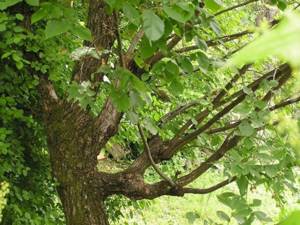
Elm is used to make parquet, wooden furniture parts, frames, and panels. Often the material is combined with lower quality wood species to give a more aesthetic appearance to the products.
Botanical description
Tree up to 20 m high, with a tent-shaped, very dense crown. The bark of young branches is brownish-ashy or yellowish; on older ones - gray.
The buds are ovoid. The leaves are ovate or rounded-ovate, 5-6 cm long, 3-4 cm wide, unequal at the base, double-serrate, short pointed at the apex, on fluffy petioles up to 1 cm long. Stipules are oblong, densely ciliated.
The fruit is an angular-round lionfish with a diameter of about 2.5 cm with a central nut position.
Flowering in March - April. Fruiting in April - May.
Rough elm
It grows under natural conditions in Russia, Central Europe, Scandinavia, and Asia Minor. There are many nature reserves in Russia, the Caucasus, Crimea, and the Baltic states. Rough elm grows in coniferous-deciduous forests, sometimes on calcareous soils.
A tree with a rounded, wide crown, reaching 35 m in height under optimal conditions. The bark on the trunk is brown, the branches are dark brown. The foliage of the slippery elm is large, sharp-toothed along the edges, rough above and coarsely hairy below, on short, pubescent petioles; yellowing in autumn. The flowers are collected in bunches. Flowering lasts 5-7 days. Quite large, green lionfish with a notch at the top, also in dense bunches.
Rough elm grows quickly. Frost-resistant. Tolerates urban conditions well. Drought resistant. Tolerates crown pruning well. Gas resistant. Rough elm propagates by seeds, and decorative forms of elm by grafting. A large tree suitable for single plantings in combination with maple and oak.
Decorative forms:
a) according to the shape of the crown: pyramidal - with a narrow pyramidal crown; Camperdown - with a rounded crown and drooping branches; weeping - with spreading main branches; low - dwarf, 2 m tall, with small foliage;
b) by leaf shape: large-leaved; curly - low-growing, slowly growing, with narrow leaves;
c) according to the color of the leaves: yellow-variegated; yellowish purple - young foliage is purple; dark purple. An interesting form of 'Lutescens' - its foliage appears creamy yellow in spring and then turns yellow-green.
Rough elm “Weeping” looks good on a trunk. An original tree with a hemispherical crown shape, similar to an inverted bowl. Long branches with large green foliage create a dense canopy under which you can hide from the sun's rays. The height of an adult tree is 5 m. It is demanding on soil. It is winter-hardy, but in cold winters the ends of the shoots freeze.
Far East, Japan, China
Habitat:
deciduous montane forests
Sizes and growth forms:
life form:
deciduous tree
monoecious
- up to 18 m;
- in Moscow at 35 years old - 9 m
crown shape:
wide-cylindrical, rounded at the top
The soil:
pH:
from acidic to alkaline
mechanical composition of the soil:
any soil
Planting and propagation:
optimal planting times:
spring, autumn
methods of reproduction:
seeds, green cuttings
Features of seed propagation:
- freshly harvested seeds germinate poorly due to the presence of inhibitors in the pericarp; mature seeds devoid of pericarp germinate quickly and completely in water, and immature seeds - slowly;
- cold stratification for 1 month and soaking seeds in a gibberellin solution strongly stimulates the germination of seeds without pericarp
vegetative propagation:
rooting rate of cuttings - 20% when treated with Kornevin
Winter hardiness:
main view:
completely winter-hardy
winter hardiness zone
Decorative:
Decoration season:
Spring Summer Autumn
Peak decorativeness:
at the beginning of fruiting, in autumn color
Decorative properties:
crown shape, leaves
Branches (bark color, shape):
young branches are gray or yellowish
Leaves:
alternate, large, with apex elongated into a pointed point or with 3-5 (7) pointed lobes
Summer color of leaves (needles):
Autumn color of leaves (needles):
Flowering time:
in Moscow it blooms in early May for 6 days
Fruiting dates:
the fruits ripen in the first half of June
Peculiarities:
frost resistance, shade tolerance, resistance to urban conditions, wind resistance
" Trees
Gardens and dachas of the new wave - stylish cottages, with a comfortable area for residents to relax, surrounded by a beautiful landscape. A traditional dacha, the main function of which is harvesting, also necessarily includes a recreation area
, lovingly decorated by the owners. It is for the spectacular design of a backyard area, a beautiful lawn, a children's playground, that ornamental plants and trees are needed, which are worth talking about in detail.
In addition to the natural aesthetic function of giving a person enjoyment of the beauty of nature, ornamental trees and shrubs are used by gardeners and designers to solve purely practical problems. Visual expansion of a too narrow or very small area. Decorating outbuildings, strengthening sloping areas and screes. Zoning the site, creating dividing screens between the vegetable garden and the garden area. Protecting the individual space of a small dacha from prying eyes, without erecting a fence.
Literature
- Genus 1. Ulmus L. - Elm, Elm or Berest // Trees and shrubs of the USSR. Wild, cultivated and promising for introduction. / Ed. volumes S. Ya. Sokolov. - M.-L.: Publishing House of the USSR Academy of Sciences, 1951. - T. II. Angiosperms. - P. 506. - 612 p. — 2500 copies.
- Genus 369. Elm, Elm or Birch bark - Ulmus L. // Flora of the USSR. In 30 t / Ch. ed. and ed. volumes acad. V. L. Komarov. - M.-L.: Publishing House of the USSR Academy of Sciences, 1936. - T. V. - P. 370. - 762 + XXVI p. — 5175 copies.
Wikimedia Foundation. 2010.
Popular ornamental trees in the garden and country house
The current trend in gardening is a beautiful, fruit-bearing garden that does not require enormous physical effort to care for and maintain its decorative appearance. The beauty and unpretentiousness of trees is a priority; the practical benefits of plantings fade into the background. This explains the popularity of new forms of fruit and forest trees presented by modern selection
:
- compact standard trees
with a spherical crown; - dwarf forms
of fruit and forest trees; - weeping
forms; - Columnar hybrids
of familiar trees.
An interesting novelty is the use of forest trees to decorate a summer cottage. For example, hornbeam seedlings are sold by nurseries at bargain prices. Hornbeam is great for creating hedges, decorative backdrops and walls.
To create spectacular compositions and edging lawns, trees of different heights are used
:
- tall (up to 6 m);
- medium tall (up to 3 m);
- low-growing and dwarf trees (up to 1.5 m).
Tall trees form a backdrop
(wall, or focal point), which is complemented by lower trees and shrubs. The undersized ones form the foreground of the composition. Trees can be decorated with gravel, located on an open lawn, solo, or combined into relief, multi-tiered groups.
The tallest ones are planted in the background, then the middle ones. Low-growing trees and shrubs are located in front.
Recognized leader - coniferous trees
Mature plants require virtually no care. Coniferous plants are decorative all year round, including winter. At the beginning of spring, many species bloom with bright lilac candles, reminiscent of Christmas tree decorations.
. Then comes the time of active growth, the young shoots are much brighter than last year’s branches. During this period, all coniferous trees look especially elegant.
Spruce grows well in marshy soils, this is especially true for the Moscow region. Pine is drought-resistant, tolerates pruning well, which allows you to vary its height and decorative shape. For low hedges and walls, we can recommend yew
. Yew holds its shape well and does not require significant pruning.
Tui
The unpretentious thuja can be safely chosen as the main decorative element of the garden, which will unite the plantings with a single design. Thujas of different varieties will fit perfectly into a composition with low-growing shrubs
, variegated and flowering trees.
In the nursery you can choose varieties of pyramidal, ellipsoidal, or spherical shape
. A garden wall made of thujas planted in a smooth line looks very interesting. This allows you to create an unusual twist on even a standard summer cottage plot.
For the middle zone, varieties and hybrids of Western thuja are recommended. The unpretentious variety Brabant is suitable for forming walls and scenes. A single thuja will grow wide; planting a thuja too close (after 0.5 m) will form a wall that is too low
. The optimal distance between seedlings of the Brabant variety is 1 m. An interesting variety is Thuja Wagner, which has a round shape and is shorter in height. Thuja loves showering, spraying, sprinkling.
Decorative maples
The most popular is maple
Canadian, Sycamore, Norway maple with burgundy foliage. They are a great solo plant on an open lawn and are good in compositions and against the backdrop of hedges.
Norway maple or sycamore burgundy color
Like most plants with brightly colored leaves, ornamental maples prefer full sun. In the shade, the natural color will fade
. Maple prefers fertile soil with neutral acidity. Young seedlings should be covered for the winter. An adult plant of a frost-resistant variety will no longer require this.
Elm hedge care
The unpretentious small-leaved elm will cause a minimum of inconvenience to its owner. Ease of planting is subsequently replaced by ease of care. However, there are many plants that can, of course, tolerate different conditions, although each has ideal growing conditions that allow it to reveal its greatest potential for beauty while being more pleasing to the eye.
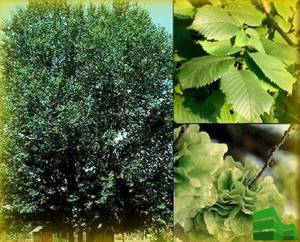
- The type of crown depends on the lighting. Lots of sun creates a dense, round crown, more suitable for single plantings. Shady areas will help achieve a more subtle shape, a bit like a weeping willow. By the way, in the first years after planting, almost all young shoots hang down.
- Some grow seedlings in pots. If you prepare a seedling in this way, it is better to spend the summer period in the yard so that the tree receives the necessary amount of fresh air.
- The growing season is characterized by more frequent watering. Regular watering is recommended to be moderate. It is bad to flood the soil, and it is also undesirable to overdry it. After post-vegetation pruning, the number of waterings is reduced.
- The lack of soil nutrients sometimes deforms the shoots. Fertilizing is carried out with organic matter.
- The most preferred type of soil is acidic soil. It is the acid that retains moisture, which enhances root growth.
- Pruning is carried out in winter (when there is no vegetative activity), giving the shoots a certain shape, or in spring, if there is a need for crown growth.
- Over time, fallen leaves form a dense layer that prevents the penetration of oxygen. It is imperative to remove fallen leaves.
- It is advisable to periodically wipe the foliage; adult plants can be sprayed with water, creating almost a “shower”. The green fence holds back the wind, leaving dust on the leaves. Gradually, dust deposits impair air circulation, which is necessary for absolutely all shoots.
Small-leaved elm hedges fit perfectly into any garden. Once you have correctly organized the preparatory work, sowing, and planned care, you can provide your site with a beautiful, impenetrable, high hedge for a long time.
